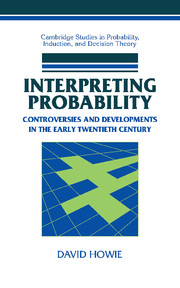Book contents
- Frontmatter
- Contents
- Acknowledgments
- 1 Introduction
- 2 Probability up to the Twentieth Century
- 3 R.A. Fisher and Statistical Probability
- 4 Harold Jeffreys and Inverse Probability
- 5 The Fisher–Jeffreys Exchange, 1932–1934
- 6 Probability During the 1930s
- 7 Epilogue and Conclusions
- Appendix 1 Sources for Chapter 2
- Appendix 2 Bayesian Conditioning as a Model of Scientific Inference
- Appendix 3 Abbreviations Used in the Footnotes
- Bibliography
- Index
2 - Probability up to the Twentieth Century
Published online by Cambridge University Press: 07 July 2009
- Frontmatter
- Contents
- Acknowledgments
- 1 Introduction
- 2 Probability up to the Twentieth Century
- 3 R.A. Fisher and Statistical Probability
- 4 Harold Jeffreys and Inverse Probability
- 5 The Fisher–Jeffreys Exchange, 1932–1934
- 6 Probability During the 1930s
- 7 Epilogue and Conclusions
- Appendix 1 Sources for Chapter 2
- Appendix 2 Bayesian Conditioning as a Model of Scientific Inference
- Appendix 3 Abbreviations Used in the Footnotes
- Bibliography
- Index
Summary
INTRODUCTION
The calculus of probability is conventionally dated from July 1654, when Blaise Pascal wrote Pierre de Fermat with a question raised by a friend, the Chevalier de Méré, concerning a dice game. The subsequent correspondence, ranging widely over gambling problems, was not the first time that games of chance had been addressed mathematically. Muslim and Jewish mathematicians in the twelfth and thirteenth centuries had calculated combinatorial rules, and Renaissance scholars in the fifteenth and sixteenth centuries had analyzed card games and dice throws in terms of the number of ways of reaching each possible outcome. Yet the two savants were the first to treat the subject in a consistent and unified way. The ‘problem of points’ posed by the Chevalier – concerning the division of stakes between players when a game is interrupted before reaching conclusion – had resisted attempts at solution from the fourteenth century. Pascal and Fermat gave the first correct general solution to this and other problems, and developed new mathematical techniques to calculate the odds in a number of card and dice games.
Following Pascal and Fermat but working largely independently, Christian Huygens derived similar results in his 1657 essay, De Ratiociniis in Ludo Aleae. Pierre Rémond de Montmort calculated the expected gains in several complex card and dice games in a publication of 1708.
Information
- Type
- Chapter
- Information
- Interpreting ProbabilityControversies and Developments in the Early Twentieth Century, pp. 14 - 51Publisher: Cambridge University PressPrint publication year: 2002
